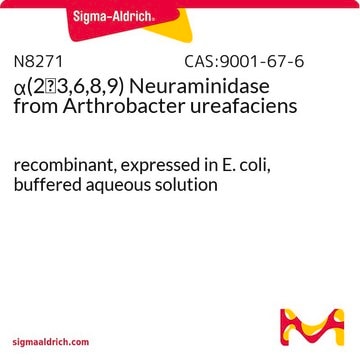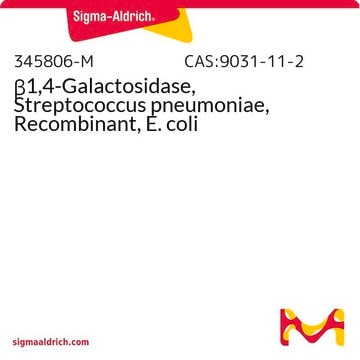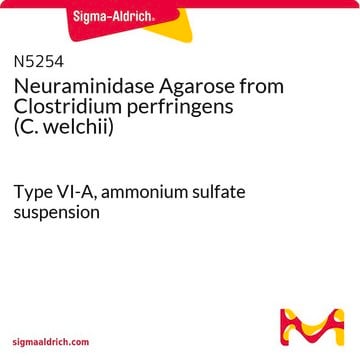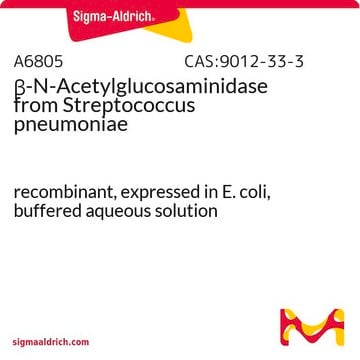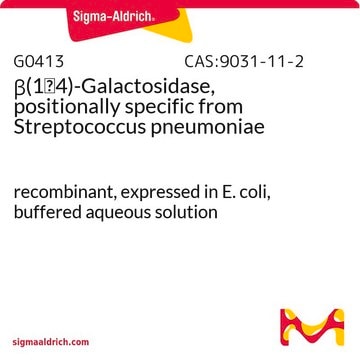It is shipped at ambient temperature, but it is to be stored at 2-8 °C for long term storage. Do not FREEZE as it is in a buffered aqueous solution.
N7271
α(2→3) Neuraminidase from Streptococcus pneumoniae
buffered aqueous solution
Sinônimo(s):
Acyl-neuraminyl Hydrolase, Acylneuraminyl hydrolase, Receptor-destroying enzyme, Sialidase
About This Item
Produtos recomendados
fonte biológica
Streptococcus pneumoniae
Nível de qualidade
Formulário
buffered aqueous solution
concentração
≥5 units/mL
atividade externa
β-Galactosidase, α-mannosidase, β-hexosaminidase, α-fucosidase, and proteases, none detected
Condições de expedição
wet ice
temperatura de armazenamento
2-8°C
Informações sobre genes
Streptococcus pneumoniae R6 ... nanB(933504)
Categorias relacionadas
Ações bioquímicas/fisiológicas
Embalagem
Definição da unidade
forma física
Nota de preparo
Palavra indicadora
Danger
Frases de perigo
Declarações de precaução
Classificações de perigo
Resp. Sens. 1
Código de classe de armazenamento
13 - Non Combustible Solids
Classe de risco de água (WGK)
WGK 1
Ponto de fulgor (°F)
Not applicable
Ponto de fulgor (°C)
Not applicable
Equipamento de proteção individual
Eyeshields, Gloves, type N95 (US)
Escolha uma das versões mais recentes:
Já possui este produto?
Encontre a documentação dos produtos que você adquiriu recentemente na biblioteca de documentos.
Os clientes também visualizaram
Artigos
Understand sialic acid structure, function, signaling, and modifications. Easily find products for sialic acid research.
-
What is the long term storage and shipping condition of ?(2—›3) Neuraminidase, Product No. N7271?
1 answer-
Helpful?
-
-
What is the molecular weight of ?(2—›3) Neuraminidase, Product No. N7271?
1 answer-
The molecular weight of this ?(2—›3 Neuraminidase enzyme is approximately 75 kDa.
Helpful?
-
-
What is the Department of Transportation shipping information for this product?
1 answer-
Transportation information can be found in Section 14 of the product's (M)SDS.To access the shipping information for this material, use the link on the product detail page for the product.
Helpful?
-
-
For ?(2—›3) Neuraminidase, Product No. N7271, what is the optimum pH range for the neuraminidase enzyme activity?
1 answer-
The optimum pH range for ?(2—›3 neuraminidase is 6.0. Please see the data sheet.
Helpful?
-
-
What are the reaction conditions of the enzyme ?(2—›3) Neuraminidase, Product No. N7271?
1 answer-
One nanomole of substrate or less can be cleaved in a 20 μL reaction volume. In the standard reaction use: 4 μL of 5X enzyme reaction "buffer B" (=250 mM sodium phosphate buffer, pH 6.0), a combined volume of 14 μL containing purified oligosaccharide and water and 2 μL of NANase I (N7271). Incubate 1 hour at 37 °C. To cleave more than one nanomole of substrate, increase reaction volume and enzyme proportionally.
Helpful?
-
Active Filters
Nossa equipe de cientistas tem experiência em todas as áreas de pesquisa, incluindo Life Sciences, ciência de materiais, síntese química, cromatografia, química analítica e muitas outras.
Entre em contato com a assistência técnica


